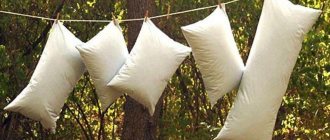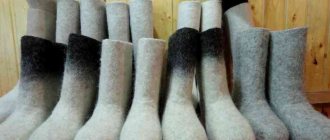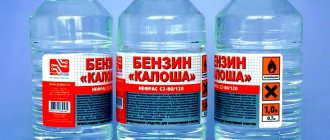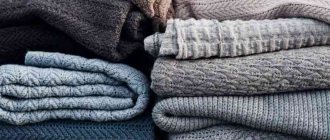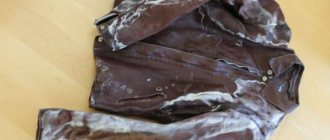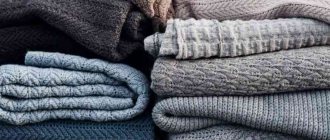Washing curtains is necessary to keep your home clean. During operation, dirt appears on the surface of the product, dust and soot particles accumulate. Kitchen curtains quickly absorb a variety of odors. In order not to spoil the appearance of beautiful curtains, you need to wash them correctly, selecting special cleaning products.
General rules
- The frequency of washing depends on factors such as place of residence, proximity to the road, climate, floor of residence, lifestyle, bad habits (smoking), presence of pets, children, type of fabric;
- Hooks, rings and other types of fastenings (except eyelets) must be separated from the fabric before washing in the machine: this will reduce the risk of damage, tightening, and equipment breakdown. Curtains with eyelets should be washed on a delicate cycle;
- It is not recommended to wash one type of curtains together with another: each fabric has its own mode;
- Kitchen curtains must be cleaned separately from snow-white tulle: a large amount of fat accumulates on them;
- If there is a significant layer of dust on the curtains, it is recommended to first soak them in a soap solution and only then wash them;
- A common mistake is stuffing too much material inside the machine. There must be at least 30% free space to ensure the required quality of washing, rinsing and spinning;
- You should always carefully read fabric labels before washing;
- Thin fabric, such as organza, dries quickly directly on the curtain rods.
Removing traces of coffee, tea and wine
Often, the curtain gets dirty with various drinks, and it is recommended to remove stains from them immediately. Your actions must be fast:
- the curtain is removed from the cornice;
- the stain is blotted with a napkin and treated with alcohol;
- a solution is prepared - add a spoonful of vinegar and the same amount of dishwashing liquid to one liter of water;
- Before the main wash begins, the curtain is soaked in this solution for half an hour.
How to wash thick fabric curtains in a washing machine
Curtains made from such materials are unpretentious and require virtually no maintenance. You can wash curtains with the usual type of powder in a washing machine. Thick, light-blocking curtains often have dirt-repellent properties and rarely need to be cleaned. An undoubted advantage is the ability of this type of fabric to smooth out under its own weight. Often, thick blackout curtains are made of dark fabrics; dirt on them is less noticeable. The same applies to taffeta.
Bottom line: any powder at any water temperature is suitable for washing thick curtains.
Blackout fabric
Black out textiles lead the market for materials used for sewing curtains. This is explained by the optimal combination of quality and price, practicality in use and ease of care, and the aesthetic properties of the material. Black out curtains do not allow street light to pass through at all, so it is advisable to use them in a bedroom or children's room. In addition, at the production stage, the fabric is impregnated with special substances that repel dust and dirt.
These curtains are washed at a water temperature of 40 °C, and you can use automatic spinning. If you hang the damp fabric on a curtain rod, you won't need to iron it.
If you follow the washing rules, home textiles will last for many years and will always have an attractive appearance.
Velvet
Velvet curtains can be washed either by hand or using a washing machine. With this capricious material, cleansing will not work in automatic mode; you need to choose a delicate one. Before placing it in the drum, you need to make sure that the fleecy side of the product is protected from friction (this is done by turning it inside out). It is important that the temperature does not exceed 30 degrees, and the process time is minimal. When washing velvet curtains by hand, you should also not rub them too hard; you need to clean them as carefully as possible and dry them on a flat surface.
Bottom line: for washing velvet curtains, the delicate mode of the washing machine or gentle manual cleaning are suitable.
What to do if you sit down?
If the curtains shrink after washing, you can take the following actions:
- Open the bottom hem. On many products it is wide enough, so it allows you to hide shrinkage of 2 cm.
- Increase the length of the curtains with fringe, which is sewn at the bottom.
- Buy hooks that will be longer.
- Move the ceiling cornice.
On the Internet you can find various solutions to the problem. Sometimes it is recommended to stretch curtains using a steam iron. Some users recommend wetting the product and increasing its length mechanically.
All these methods are irrational, since it will not be possible to achieve uniform tension, but it is quite possible to spoil the product in this way. Therefore, it is easier to prevent a problem than to spend energy and money on eliminating it later.
To prevent the curtains from shrinking, you need to follow the washing temperature, do not wring them out and dry them flat.
Silk, satin
The joy of buying new curtains that transform a room into a luxurious hall can be overshadowed by improper washing. It is easy to spoil delicate satin fabric, but it is almost impossible to restore it after that. You should not use silk curtains in the kitchen: they get dirty very easily, any stain on them is noticeable.
Satin fabric requires placement in a wash bag or regular pillowcase. This measure is used to ensure that the appearance does not deteriorate due to mechanical damage. The mode is delicate, the temperature is minimal. Some modern washing machine models provide a special mode for silk. Clean curtains should be dried by hanging them in place.
Simple rules for removing stains from silk curtains:
- The stain is removed before washing, not after;
- If it has just been installed, there is a chance to get rid of the dirt by simply wiping it with a damp cloth (do not rub under any circumstances);
- If oil or other fat has been dropped, you need to wipe it with a cloth, then sprinkle with corn grits for a while for complete absorption;
- Vinegar can help remove iron marks by soaking a gauze cloth in it and then steaming it.
Bottom line: silk and satin curtains are washed at minimum temperature with a gentle cycle, in a special bag or pillowcase.
Basic recommendations
Let's try to summarize everything said above and list everything that is required for proper care of curtains, regardless of the type and size of the window leaf.
- Study what is written on the tag and follow the instructions.
- Make sure you know exactly the composition of the fabric and are sure that they can be put into the machine. Also check to see if the decorative elements are damaged.
- Do not fill the machine drum tightly, otherwise contaminated areas will remain and the cloth will not be rinsed completely. This will lead to streaks on the curtain. If the size of the panels is very large, then it is better to wash one at a time and include an additional rinse.
When the drum is half loaded, the fabric is washed better and rinses well - Do not use solid powder, but shampoo or liquid gel. This will prevent damage to the fibers. Special bleaching agents have been developed for white curtains.
- Be sure to use a washing bag, this will protect the tank of the machine and the curtains themselves from being pulled in, and will prevent damage to the decor.
- Do not place any items with the curtains. Leave only the curtains and nothing else.
- Turn off the centrifuge; spinning causes creases and damage. Allow the water to drain on its own.
- Washing in a washing machine is much easier than washing by hand and makes life easier for housewives.
If you follow the fabric care recommendations, the life of the curtains is extended, and washing becomes simple and effective.
Do you doubt whether you should do your own laundry? Invite experts to your apartment for consultation. Now there are companies that provide such services at home; you won’t need to carry heavy curtains yourself.
Curtains
Kitchen curtains are often made from cotton and linen, since these fabrics can be washed at high temperatures (40-60 degrees).
Even heavy stains from fat and soot are removed with this type of washing. But in order to iron curtains made of linen or cotton, there is one trick: do not turn on the spin cycle after rinsing, but iron them slightly damp. Instead of spinning, it is better to turn on an additional rinse: this will remove the detergent more thoroughly, which is especially important if the windows face the sunny side. The detergent will not interact with ultraviolet radiation, the color and pattern of the curtains will not change. If the curtains have a pattern or embroidery, they should be ironed from the wrong side.
Bottom line: linen and cotton curtains are suitable for washing at a temperature of 40-60 degrees, double rinsing, ironing without spinning.
Video on the topic:
Ironing rules
The curtains begin to be ironed from the top, gradually moving the fabric towards the floor. You can place a table or several chairs close to the ironing board, where the ironed material will lie.
Frills and edging are ironed first. The temperature control should be set to the appropriate position for the type of fabric. You cannot hold the hot sole of the iron in one place for a long time.
The use of a vertical steamer greatly simplifies the ironing process. In this case, you can iron the curtain while hanging. Steam treatment is only suitable for dense materials. This method is not used for nylon, chiffon, organza.
Tulle
The worst thing for this type of fabric is high temperatures. An iron or boiling water can easily turn new snow-white curtains into a yellow misunderstanding. To maintain their whiteness, you just need to wash them more often in warm water. Do not use detergents containing chlorine when washing. A bag or pillowcase will also come in handy here; under no circumstances should the tulle be folded into the drum crumpled up.
Folk remedies for whitening tulle:
- Prepare a salt solution (a tablespoon of salt per liter of liquid), soak the tulle before washing;
- Make a solution from a tablespoon of ammonia, 2 tablespoons of hydrogen peroxide and hot water. Immerse the tulle there for half an hour, rinse.
Bottom line: it is correct to wash tulle in lukewarm (30 degrees optimal) water, without spinning, with a small amount of detergent. Additional rinsing and pre-soaking are recommended for perfect whitening. To avoid yellowing, wash more often.
Is it possible to remove difficult stains?
They spoil the appearance of the products and the room as a whole, and create a bad mood for the hostess. There are many different ways to help remove stains of different origins. But general requirements must be met:
- Pre-remove dust from the surface of stains;
- the lining on the curtain should be torn off;
- stains are removed with cotton swabs, the edges are sprinkled with starch;
- cleaning is carried out from the edge to the center of the contamination;
- The cleaned area is watered with warm water.
Kiseya
If every person, when purchasing thread curtains, thought about how he would wash them, sales of this type of curtain would drop sharply. The fact is that cleaning such curtains is a rather complicated process. Under no circumstances should curtains made of beads or glass beads be machine washed! Fabric curtains made from ropes can be machine washed, but a number of preparatory steps must be taken to ensure that they do not get tangled or deformed.
- Divide the curtains into parts, braid several braids from them;
- Without tightening the braid too much, tie an elastic band or ribbon at its end;
- Another option: tie the curtain with elastic bands/ribbons along the entire length at a distance of 10-15 cm from each other;
- Important! The material of the elastic band or ribbon should be light;
- For even greater protection, place the braided curtain in a bag.
The temperature is chosen average - 30-40 degrees. It is recommended to use liquid detergent rather than powder. Don't push!
For rope curtains, hand washing is acceptable. To do this, dissolve detergent in warm water, place the prepared product for a quarter of an hour, add hot water. Carefully crumple the curtain with your hands, then rinse and hang.
Important! Do not dry thread curtains tied: they will become deformed.
Bottom line: There are two washing options for thread curtains, both of which require preparation - tying/braiding. The temperature should not be high, it is better to use a bag.
Preparation
The preparatory stage is very important and the final result also depends on it. To begin with, the curtains should be shaken well (it is better to do this outside) to remove all accumulated dust. Canvases with eyelets must not be shaken out, so you can use a vacuum cleaner. Be sure to inspect the curtains for stains and heavy dirt. If they are, move on to the next stage.
Washing items with stains or traces of grease cannot be done without soaking. Add a suitable product to a bowl of cool or warm water and leave for 30-60 minutes. It is not advisable to rub them, otherwise there is a risk of damaging the fabric fibers. You can raise and lower the curtains into the basin several times to create foam. All that remains is to rinse the curtains in clean water and proceed to the main stage.
How to wash roller blinds?
This type of window decoration not only perfectly complements any interior, but is also very functional: curtains do not take up space in a small apartment, are easy to raise and lower, and can even serve as a means of zoning. Compared to ordinary fabric curtains, roller curtains look modern, are easy to care for, and light ones can be used instead of capricious tulle.
There are several ways to clean dirty curtains if the need arises.
| Cleansing method | Dry method | Dry cleaning | Removing stains | Wet method |
| How to do it | Using a vacuum cleaner (you will need a soft attachment and a cloth for extra protection) | With the help of professionals | An eraser, an ordinary eraser from any company will do. | Roller blinds are cleaned with a neutral detergent and a soft cloth or sponge. After this, the product is removed in the shower and dried horizontally. |
Removing grease stains
It is necessary to remove a grease stain immediately, while it is fresh and easier to deal with. There are several ways to do this:
- the stain is sprinkled with talcum powder or starch. White paper is placed under the fabric, the stain is sprinkled and left for a day;
- The pulp of black bread effectively removes grease stains;
- the stain is removed with chalk or tooth powder;
- old grease stains are removed with ammonia or glycerin.
How to wash Roman blinds?
The easiest way to clean such curtains is with a vacuum cleaner. But sometimes more thorough cleaning is required, then you need to remove the slats so that machine washing is possible. It is important to know what material Roman blinds are made of in order to choose the right washing method and temperature. Any powder is suitable for cotton curtains; in some cases, you can even dry them in a machine.
It is better not to machine wash curtains made of synthetic materials; they should also not be washed at high temperatures. In this case, soaking in a detergent that does not contain chlorine is ideal.
Attention! Curtains made of bamboo/rope should not be washed, as mold may appear.
Bottom line: Roman shades are machine washable, but not if they're made from synthetic materials.
Hand washing method
This process is labor-intensive. But he is given preference. As the most careful. In addition, there are products that cannot be machine washed. There are several rules for hand washing:
- There should be a sufficient amount of water. It is better to organize washing in the bathtub;
- washing powder is not poured onto the surface of the fabric - it is diluted first, then the material is immersed in water;
- products made from thin fabric do not rub or wring out;
- it is necessary to first test the material for bleach if you plan to use it;
- It is not recommended to squeeze out the water - it should drain on its own;
- Salt water is used for soaking and washing.

